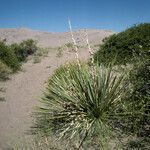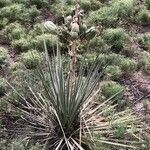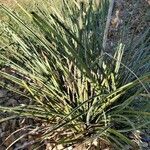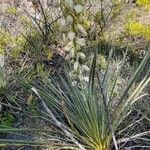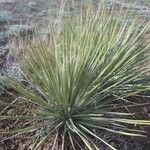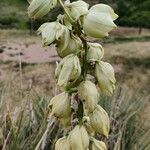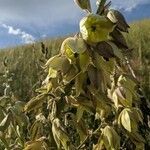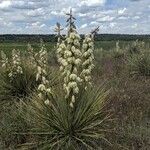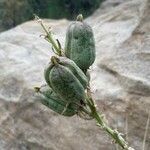Plants forming small to moderate colonies, acaulescent or caulescent and arborescent, occasionally branched; rosettes 1–15 per colony, usually small. Stems erect, to 0.4 m. Leaf blade linear to linear-lanceolate, concave to concavo-convex, widest near middle, 40–60 × 0.8–1.2 cm, rigid, margins entire, filiferous, white, apex blunt to acicular. Inflorescences racemose, occasionally paniculate proximally, arising within or just beyond rosettes, 5–10 dm; bracts erect, leaflike, 2–5 cm, reduced toward apex; peduncle scapelike, 0.2–0.5 m, less than 2.5 cm diam. Flowers pendent; tepals distinct, greenish white to white, elliptic, 5–5.3 × 2.6–3.5 cm, apex acute; filaments white, 1.7–1.9 cm; anthers yellow, 4 mm; pistil green, obovoid, 3–3.7 × 1.7 cm; style dark green, 10 mm; stigmas lobed. Fruits erect, capsular, dehiscent, cylindric to obovoid, rarely constricted, 5–8(–9) × 3–4.5(–5) cm, dehiscence septicidal. Seeds black, slightly glossy, thin, 9–12 × 8–9 mm.
More
Caudex very short, sometimes prostrate; lvs widely radiating, stiff, linear, to 8 dm, rarely over 1 cm wide, fibrous along the white margin, gradually tapering to a short slender spine; infl racemose or with a few short branches, rising to 1–2 m, its base not or scarcely elevated above the lvs; tep ovate to lanceolate, 4–5 cm, usually acute; fr prismatic, 5–7 cm; seeds 8–10 mm. Dry prairies and plains; w. Io. and Mo. to Mont., Wyo., Ariz., and Tex. June (Y. arkansana)
A small shrub. It grows 60 cm high and spreads 90 cm wide. It forms clumps. The leaves are narrow and blue-green. There are thin straight threads along the edges. The flower stalk is 0.9 m tall. The flowers are off-white and bell shaped. Sometimes there are tinges of green or red-brown. The fruit are about 8 cm long and 1 cm wide. These capsules contain many seeds.
Immature fruit are peeled, boiled and eaten with butter and seasoning. Young flower stalks are cooked and the soft inner portion eaten. Flowers and flower buds are eaten raw in salads or used as a pot herb. The fruit are sun dried for later use.
